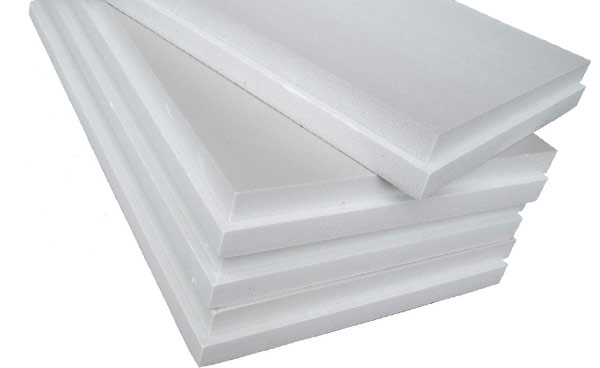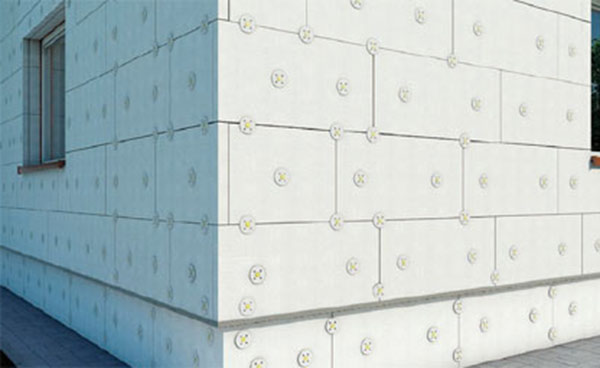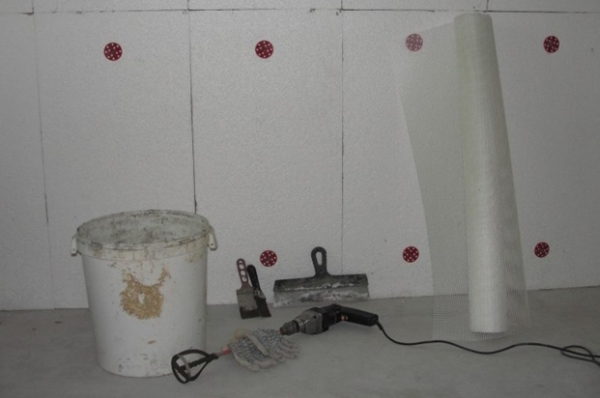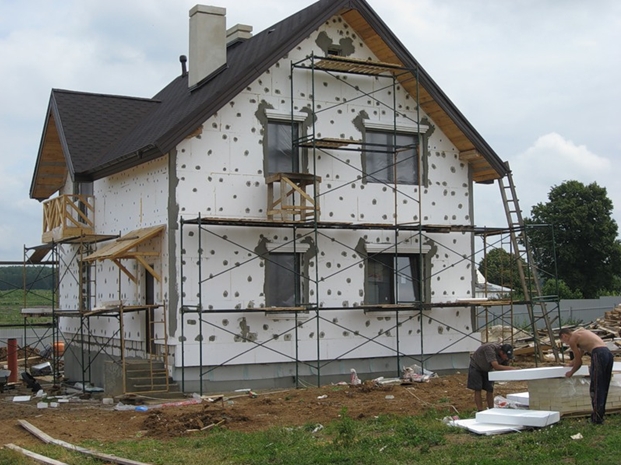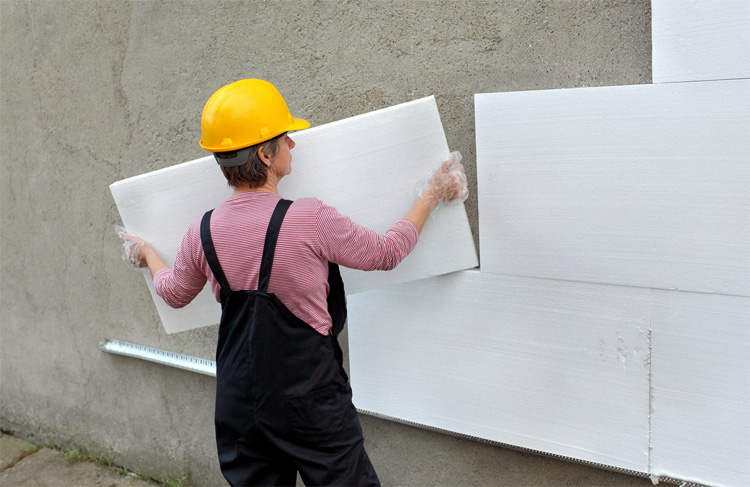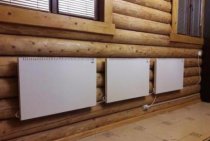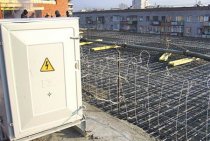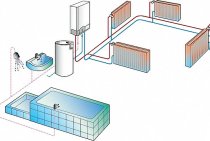A little about foam
Installation of expanded polystyrene boards under siding is a cost-effective solution for creating an optimal thermal insulation layer. In addition, the material has good sound insulation characteristics, is environmentally friendly and does not burn.
Despite the fact that expanded polystyrene is not combustible, it melts under the influence of high temperatures or open fire. At the same time, combustion products are released into the atmosphere, which, if they enter the respiratory system of a person, can cause injuries incompatible with life.
Currently, two types of polystyrene foam boards are used in individual construction, any of them can insulate your own house from the outside, followed by finishing for siding:
- Ordinary foam;
- extruded.
| Insulation type | Thermal conductivity, W/(m*K) | Water absorption,% | Density, kg/m3 |
| Styrofoam | 0,03 | 0,1-0,2 | 25-35 |
| Extruded foam (styrofoam) | 0,028 | 0,3-0,5 | 32-38 |
The table shows the average values of the coefficients of materials, depending on the manufacturer, they may differ slightly from those indicated.
Material Features
Styrofoam is 98% air, which allows it to retain the maximum amount of heat in the premises. Therefore, this material is used not only for insulating the walls of residential buildings, but also for ceilings, floors, basement floors, foundations and storage facilities.
Is it really the only reason styrofoam has become so popular. Not at all. There are other positive qualities inherent in this material.
Advantages
Let's start, as usual, with the advantages, because it is thanks to them that homeowners choose polystyrene foam for insulation:
- Sound and heat insulation of rooms.
- Light weight, which helps to reduce the load on the load-bearing walls. This means that expanded polystyrene is also suitable for very old buildings.
- Versatility of application. It can be used both for internal and external works, for residential and non-residential premises.
- Moisture repellent properties.
- Affordable price. The cost of polystyrene is quite low compared to other materials.
- Duration of operation. This advantage can be considered relative, since unprotected foam plastic under the influence of sunlight quickly collapses. But if it is closed immediately after installation with a facing material, then the service life will be up to 30–35 years.
- Safety. The foam is coated with antipyrines, which prevent the heat insulator from smoldering and releasing caustic substances.
- Prevalence. This heater can be found in any hardware store. At the same time, plates of different density and thickness are presented at one point.
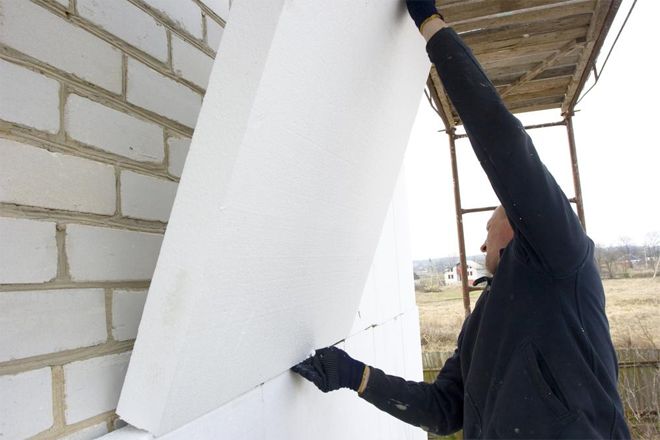
Flaws
Pluses are pluses, but each material has several disadvantages. They should not be ignored at all and sometimes, a few minuses can outweigh a large number of positive points. Polyfoam also has its drawbacks:
- fragility. A plate of any density and thickness breaks easily. This must be taken into account in the process of trimming and installation, it is advisable to be as delicate as possible with this material;
- little steam capacity. You should not rely on natural ventilation if the house is sheathed with foam. Vapors will accumulate in the rooms, and this will lead to a deterioration in the microclimate. This material is categorically not suitable for the insulation of wooden buildings;
- does not tolerate exposure to ultraviolet radiation and some paints and varnishes;
- if the foam is not coated with antipyrines, then it ignites easily, and acrid smoke is released;
- love of rodents and birds. Rodents settle in the slabs and make their nests.Birds dig holes in slabs that are not covered with facing material.
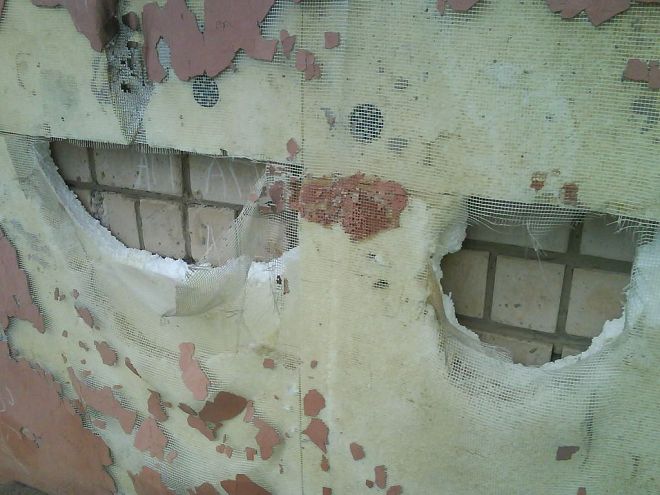
Pros and cons of insulation from the inside
Before doing the work with your own hands, you need to study all the nuances. The thermal insulation of walls inside the room is not the right solution from the point of view of such a science as heat engineering. This method becomes only acceptable when it is impossible to use another. The disadvantages of insulating the wall of the house from the inside are as follows:
- reduction of the useful area of internal premises;
- the measures taken do not prevent the freezing of the walls, and therefore do not protect them from destruction;
- the dew point (condensate) is inside the load-bearing wall of the house (high probability of moisture accumulation).

The dew point is at the junction of the wall and the foam, therefore, in order to avoid condensation, it is extremely important to apply a vapor barrier
It is possible to insulate with foam from the inside only if there is a serious need for it. Most often, do-it-yourself work should be done in the following cases:
- Thermal insulation of rooms in a multi-storey building. To insulate the apartment with polystyrene foam from the outside, you will need to hire industrial climbers. Such services are expensive, so as an alternative, protection from the inside can be applied.
- Insulation of the walls of the house with a new cladding. When doing do-it-yourself work in a private house, it is necessary to take into account the condition of the facade decoration. If the exterior work has been completed relatively recently, it is not economically feasible to disassemble the cladding. In this case, you can also fix the thermal insulation from the inside of the walls.
Mice start in foam
And one more fact that must be indicated when evaluating the pros and cons of foam insulation is that mice start up in the material.
Expanded polystyrene is an ideal habitat for them, because it is warm and soft. Therefore, when insulating with polystyrene foam, close the access of mice. To do this, you can finish the places where rodents can enter with mineral wool, which mice do not like.
Therefore, although polystyrene foam has a number of positive qualities, one should not forget about its disadvantages. Therefore, it should be used thoughtfully and according to all the technological features of the material.
How to properly insulate a house with foam plastic from the outside
Everyone knows that a significant percentage of heat loss falls on the walls of the house, especially if they are not insulated. In this case, even a modern and efficient heating system will not cope with high-quality heating of the room. If you know how to insulate a house with foam plastic from the outside with your own hands, you can save a lot and not involve a specialist.
Advantages of external wall insulation with foam plastic
Warming the house outside can be done in two ways: outside and inside the room. Experts advise to perform work from the street side, in this case:
- the usable space of the house is saved;
- there is no need to perform an additional layer of vapor barrier;
- a multi-layer structure is provided that prevents moisture from entering the room;
- the properties of the house to save heat increase, which allows you to save money by reducing heating costs.
What foam is better to insulate the house
Perhaps you are interested in the question of whether it is possible to insulate a wooden house with polystyrene foam, and also how much such insulation costs. Wooden houses, as well as ordinary ones, need to be insulated. Heat will quickly leave through the timber, which means that the house will become uninhabitable in winter. The price of insulation depends on the size of the house, as well as which company you contacted. You can save money with self-insulation of the house from the outside.
How to choose foam for house cladding? For insulating facade work, foam in the form of sheets with a thickness of at least 10 cm is considered the best option. Knowing how thick the foam is to be insulated from the outside and from the inside, you can achieve good results and save on home heating.
There are 2 types of foam:
- Fragile. This material breaks easily, crumbles.
- Building. It is very dense, but at the same time light. It cannot be sold.
Both types are great for insulating work: the denser one holds heat well, while the porous one withstands distortions and is cheaper.
Learn how to insulate the walls of a house made of aerated concrete
The positive properties of foam for insulation outside
- ease of use, ease of attachment to the surface;
- affordable price;
- seismic resistance;
- not subject to decay;
- high heat-saving characteristics.
The disadvantages of foam insulation are as follows:
- It is an artificial material, so environmental cleanliness is in question.
- Flammable.
- During combustion, harmful substances are released;
- Very fond of mice as a place to stay.
Step-by-step instructions for warming the facade of the house from the outside on your own
Useful for work:
- sheet foam;
- fasteners;
- mounting adhesive;
- reinforced mesh;
- putty;
- primer;
- drill;
- sharp knife;
- spatulas;
- hammer.
Step 2: preparing the walls
Step 3: Installing the Styrofoam
If the wall of the house outside was properly prepared, then it will take a little time to glue the foam sheets. Glue with a spatula is applied to the sheet, the excess is removed with a notched trowel. Additionally, glue is applied to the surface of the wall. A sheet of foam is carefully applied to the wall and lightly tapped to secure it.
Step 4: fixing on nails
The outer surface of the house is left for 3 days for the glue to dry, after which it is fixed on nails of a special type. They are hammered along the edges and, for reliability, one in the center.
Step 5: Paste the Mesh
A layer of glue is applied to the foam, then a mesh is applied. Using a spatula, you need to smooth it out and, if necessary, add an adhesive composition. First, the mesh is stretched at the corners, then distributed over the entire surface. From the edge, you need to leave 10 cm of the grid without glue, for joining with the next layer. When the surface dries, wipe it with sandpaper, apply finishing putty or decorative plaster on top.
As you can see, the technology for insulating the facade of an ordinary or timber house with foam plastic is simple, and if carried out correctly, it will give tangible results. Now you know how to carry out external insulation of the house with foam plastic with your own hands and you can decide for yourself whether it is worth insulating with this material or not.
What do you need to work
Before proceeding with the installation of foam, the necessary materials and tools are purchased and prepared.
Materials:
- Styrofoam;
- Adhesive composition suitable for the material;
- Mounting foam;
- dowels;
- Primer and plaster;
- Construction mesh for reinforcement;
- Starting bar.
Tools:
- Drill (well, if there is a mixer nozzle);
- Notched trowel for applying adhesive;
- Ordinary spatulas;
- Construction knife;
- Container for diluting glue;
- Roulette;
- Level;
- Drill;
- Graters with teeth of various sizes.
It is important to purchase the “correct” foam for wall insulation. To do this, its density should be about 25 kg per cubic meter.
The thickness of the plates should be at least 8 cm, 10 is most often used.
You can fix the foam with glue or dowels. But as practice shows, both are better. Glued sheets in several places are fixed with nails for greater strength.
Optionally, a starting profile-bar is installed at the bottom of the wall, which serves to secure the position of the sheets and prevents them from sliding during installation.It also prevents damage to the foam by rodents, so if there is a problem of visiting uninvited guests, then it is better to use it.
Material advantages
Despite the cheapness, polystyrene is a high-quality and safe material. Information about toxicity is just a myth. The main property due to which it is actively used in the cladding of houses is its high thermal insulation qualities.
Also, the material has many more advantages:
- High soundproofing properties.
- Light weight, which reduces the load on the foundation and walls.
- The material is resistant to water and does not deform in high humidity.
- Does not ignite.
- Durable and does not lose its properties for about 50 years.
- prevalence and availability. You can buy polystyrene at any hardware store.
But all these advantages apply only to high-quality material and with proper installation. How to sheathe a house with foam?
Where to use
Universal material that can be used to insulate any surface:
- Roofs and walls.
- Floor and plinth.
- Industrial buildings and residential buildings.
This is one of the easiest ways to insulate, so many use foam. The house will become comfortable and warm, and the insulation itself is very reliable. The installation work itself and the material are inexpensive, so if you wish, you can hire a team of workers for these purposes.
Styrofoam sheets are more often used to insulate walls, and crumbs or balls are taken for the roof. The floor and base are often insulated with extruded polystyrene foam.
